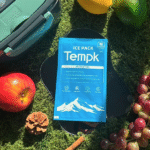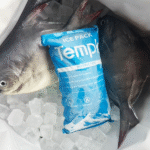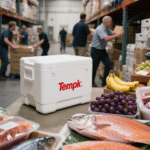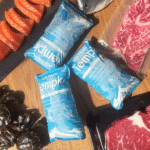Introduction:
In today’s fast-paced logistics world, ensuring that temperature-sensitive goods like pharmaceuticals, food, and biotech products are kept within precise temperature ranges is crucial. Traditional dry ice is slowly being replaced by innovative solutions, such as ice substitute dry ice packs, which offer several advantages. These packs are particularly important for industries requiring strict temperature control, providing an efficient and safe way to transport goods. In this article, we’ll explore the benefits, applications, and trends shaping the use of ice substitute dry ice packs in 2025 and beyond.
-
How do ice substitute dry ice packs work?
-
Which industries benefit most from using these ice packs?
-
How can you choose the right ice substitute dry ice pack for your needs?
-
What are the cost implications and environmental benefits of these packs?
How Do Ice Substitute Dry Ice Packs Work?
Ice substitute dry ice packs are designed to provide effective cooling without the risks associated with traditional dry ice. These packs use phase change materials (PCMs) or gel-based substances that absorb and release heat at specific temperatures. Unlike dry ice, which sublimates and creates carbon dioxide gas, ice substitute packs maintain cold temperatures through a more stable, non-hazardous process.
Core Mechanism: When the phase change material inside these packs changes state (from solid to liquid or vice versa), it absorbs or releases large amounts of energy, keeping the surrounding products at a stable temperature. This ability makes them particularly useful for transporting pharmaceuticals, vaccines, and perishable goods.
Key Components of Ice Substitute Dry Ice Packs:
-
Insulation Layer: Minimizes heat transfer, ensuring that the cooling effect is prolonged.
-
Phase Change Core (Dry Ice Equivalent): The cooling mechanism, responsible for absorbing heat and maintaining the required temperature.
-
Protective Outer Shell: Durable, lightweight materials that protect the contents during transit, ensuring the pack remains intact.
| Component | Description | Significance |
|---|---|---|
| Insulation Layer | Reduces external heat transfer | Prolongs cooling effect |
| Phase Change Core | Absorbs and releases heat at specific temperatures | Maintains consistent temperature |
| Protective Outer Shell | Lightweight and durable | Enhances safety and ease of transport |
What Industries Benefit the Most from Ice Substitute Dry Ice Packs?
Ice substitute dry ice packs are crucial for industries that rely on temperature-sensitive products during transit. Some of the industries that benefit the most include:
Pharmaceuticals:
-
These packs are essential for transporting drugs, vaccines, and biologics, which require precise temperature control to remain effective.
Food and Beverage:
-
Ensuring freshness of perishable goods such as meats, dairy, and frozen foods is vital. These packs ensure that food products stay fresh from the manufacturer to the end customer.
Biotechnology:
-
Many biotech products, like biological samples, need to be transported at strict temperature ranges to maintain their integrity. Ice substitute dry ice packs help preserve these materials.
How to Choose the Right Ice Substitute Dry Ice Pack for Your Shipment?
Choosing the right ice substitute dry ice pack involves understanding the nature of the goods being shipped, the required temperature range, and the duration of the shipment. Here are some key considerations when selecting the right pack:
1. Temperature Requirements:
-
Ice substitute packs can be tailored to maintain specific temperature ranges, typically between 2°C and -20°C, depending on the material inside.
2. Duration of Cooling:
-
Consider how long the shipment will take. For longer durations, you may need larger or more robust packs that offer longer cooling durations, typically 12 to 48 hours.
3. Size and Fit:
-
The size and shape of the pack should fit within the designated shipping containers, ensuring optimal performance and no space wastage.
Tip: Always run a test before full-scale use to ensure the chosen pack meets your cooling needs under real-world conditions.
Cost Implications and Environmental Benefits of Using Ice Substitute Dry Ice Packs
While the upfront cost of ice substitute dry ice packs may be higher than traditional ice, their long-term savings and environmental benefits make them a worthwhile investment.
Cost Factors:
-
Reduced Spoilage: By maintaining consistent temperatures, these packs help reduce product spoilage, saving businesses money by minimizing waste.
-
Better Compliance: Industries with strict temperature control regulations, like pharmaceuticals, can avoid costly penalties by using these packs to stay compliant.
-
Improved Customer Satisfaction: By ensuring that products arrive in optimal condition, businesses can enhance customer loyalty and build a reputation for reliability.
| Cost Factor | Benefit | Impact on Your Business |
|---|---|---|
| Reduced Spoilage | Less waste, fewer damaged goods | Higher profit margins |
| Compliance Costs | Avoid regulatory fines | Maintains reputation and trust |
| Customer Satisfaction | High-quality, safe delivery | Increased customer loyalty |
Environmental Benefits:
-
Eco-friendly Design: Many ice substitute dry ice packs are reusable and made from biodegradable materials, making them a sustainable choice.
-
Lower Carbon Footprint: Unlike dry ice, which produces CO₂ emissions when it sublimates, these packs help businesses meet sustainability goals while still offering effective temperature control.
2025 Trends in Ice Substitute Dry Ice Packs
Innovation in Materials:
The demand for eco-friendly solutions in cold chain logistics is pushing manufacturers to develop sustainable materials for ice substitute dry ice packs. These materials improve thermal insulation while minimizing environmental impact, making them an attractive choice for businesses looking to reduce their carbon footprint.
Integration of Smart Technology:
Advances in technology are also being integrated into these packs. Smart sensors are now being used in some packs to provide real-time temperature monitoring, alerting users if temperatures deviate from the desired range. This helps reduce the risk of spoilage and improves shipment reliability.
Frequently Asked Questions
Q1: How long do ice substitute dry ice packs last?
Typically, ice substitute dry ice packs last 12 to 48 hours, depending on the pack size and environmental conditions.
Q2: Can I use ice substitute dry ice packs for shipping food?
Yes, these packs are ideal for shipping temperature-sensitive foods, such as frozen items, dairy, and meat, ensuring that they remain fresh during transit.
Q3: What makes ice substitute dry ice packs better than traditional dry ice?
Ice substitute packs offer longer-lasting cold, non-hazardous handling, and lower environmental impact, making them a superior alternative to traditional dry ice.
Conclusion and Recommendations
Ice substitute dry ice packs are transforming cold chain logistics by providing a safer, more efficient, and cost-effective way to transport temperature-sensitive products. By selecting the right pack based on your shipment’s requirements, you can improve efficiency, reduce spoilage, and enhance compliance.
Next Steps:
Evaluate your current cold chain logistics processes and consider integrating ice substitute dry ice packs into your operations for improved product safety and operational efficiency.
About Tempk
At Tempk, we specialize in offering industry-leading cold chain solutions. Our ice substitute dry ice packs are designed for maximum performance and sustainability, ensuring your temperature-sensitive goods stay safe during transit. We offer tailored solutions to meet your logistics needs with a focus on innovation and reliability.
Contact Tempk today to learn more about how our ice substitute dry ice packs can enhance your shipping operations.























